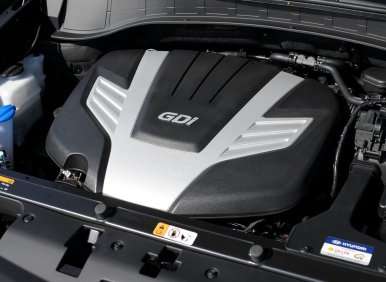Recent Articles
Popular Makes
Body Types
10 Things You Need To Know About The 2013 Hyundai Santa Fe

Part of staying alive is keeping oneself on the move, and there are few automakers out there as lively as Hyundai. A spate of recent product introductions made over the last 12 months has included a substantial update to its SUV lineup in the form of not one, but two new models debuting under the name of the 2013 Hyundai Santa Fe. If the Hyundai Santa Fe had previously formed the core of the Korean brand’s crossover identity then that role is now doubly true, making the vehicle one of the most important in the Hyundai showroom. A significant amount of attention and care has been taken in putting together the Santa Fe in order to make sure that it can compete hard against the current crop of family-friendly conveyances.
Let’s take a look at 10 things you need to know about the 2013 Hyundai Santa Fe.
01. The 2013 Hyundai Santa Fe Is All-New
The 2013 Hyundai Santa Fe represents a big step ahead when compared to the 2012 model. This is immediately obvious when approaching the vehicle for the first time, as the new Santa Fe takes the automaker’s fluidic sculpture design language in a fresh direction that attempts to add-in a little bit of gruffness and muscle to what was previously a sleek styling exercise. Inside the crossover, everything from the dashboard to the door panels to the seats have been worked-over to add to the high-end feel that Hyundai has made a trademark in even its least expensive products.

02. The 2013 Hyundai Santa Fe Features Two Body Styles
Perhaps the biggest deviation from the old Santa Fe’s game plan is the arrival of two distinct body styles for the current edition. The 2013 Hyundai Santa Fe provides both five and seven passenger editions, with the former going by the name of the Santa Fe Sport. Eight-and-a-half inches of length separate the two vehicles, and the larger model not only improves total cargo capacity from 71.5 cubic feet to 80 cubic feet, but it also adds extra legroom to the second row of accommodations. The seven-passenger model’s additional inches also allow it to cram as much as 41 cubic feet of gear between the rearmost seatback and the vehicle’s liftgate.
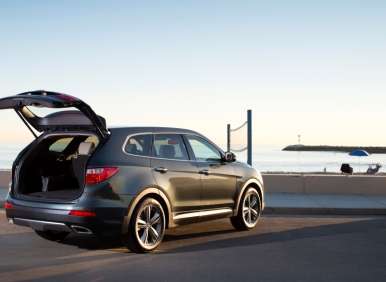
03. The 2013 Hyundai Santa Fe Offers Three Engine Choices
The 2013 Hyundai Santa Fe Sport offers a pair of four-cylinder engines on its options sheet. The base model is equipped with a 2.4-liter unit that delivers 190 horsepower and 181 lb-ft of torque, while 2.0T editions feature a turbocharged 2.0-liter mill that generates 264 horses and 269 lb-ft of torque. The latter engine puts the sprint to 60-mph in the eight second range. The long-wheelbase Santa Fe steps up to a direct-injection 3.8-liter V-6 that provides 290 horsepower and 252 lb-ft of twist. Each of these power plants can be found in other Hyundai models, with the four-cylinders hailing from the Sonata lineup and the V-6 borrowed from the Azera stable.
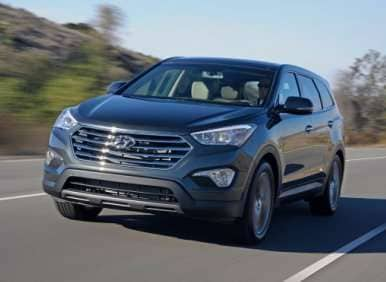
04. The 2013 Hyundai Santa Fe Provides Good Fuel Economy
The inclusion of a six-speed automatic transmission with each and every engine option for the 2013 Hyundai Sonata helps it to offer solid fuel mileage figures across the board. Those who elect to stick with the base 2.4-liter, four-cylinder engine in the Santa Fe Sport benefit from 21-mpg in city driving and 29-mph on the highway, but even the vehicle’s turbocharged, 2.0-liter upgrade exacts only a one and two mile per gallon penalty for each respective measure. The heavier long-wheelbase Santa Fe’s V-6 knocks the crossover’s fuel efficiency rating down to 18-mpg in stop and go driving and 25-mpg during highway cruising.
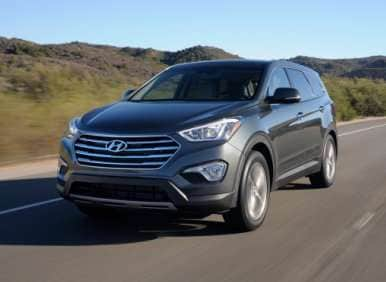
05. The 2013 Hyundai Santa Fe Can Be Had With All-Wheel Drive
It is practically impossible to find a sport-utility vehicle on the modern market that doesn’t provide buyers with the option of either a four-wheel drive or an all-wheel drive system for handling slippery, wet, or snow-covered roads. What makes the 2013 Hyundai Santa Fe somewhat unique, however, is the ability to order all-wheel drive even when selecting its base trim – a flexibility that is absent when examining several of its competitors. In addition to the extra grip provided by available all-wheel drive, the Santa Fe can be had with Active Cornering Control (which provides torque vectoring to improve stability through a turn), and an adjustable steering feel feature that tunes its electric power steering system between comfort and sport settings (three in total).

06. The 2013 Hyundai Santa Fe Is Available In Four Trim Levels
The 2013 Hyundai Santa Fe Sport’s base trim offers a long list of standard features, including air conditioning, power windows and door locks, Bluetooth connectivity, a USB interface for its stereo system, 17-inch rims, cruise control, and the Blue Link telematics system. The 2.0T enhances the crossover’s interior package by swapping in more attractive gauges, and it also up-sizes the Santa Fe Sport’s rims to 19 inches and adds keyless entry, heated front seats and side mirrors, a power driver’s seat, fog lights, and a leather-wrapped steering wheel to the equipment list.
The 2013 Hyundai Santa Fe GLS represents the most affordable version of the long-wheelbase model, and while it largely mimics the gear found in the standard short-wheelbase edition of the SUV it also grafts on 18-inch rims and fog lights. The top-tier Santa Fe Limited goes whole hog, incorporating all of the items found on the GLS combined with the 2.0T trim while adding leather seats (heated up front and in the second row), dual automatic climate control, a touchscreen for interacting with the vehicle’s infotainment system, captain’s chairs to replace the second row 's standard bench, and a power liftgate.
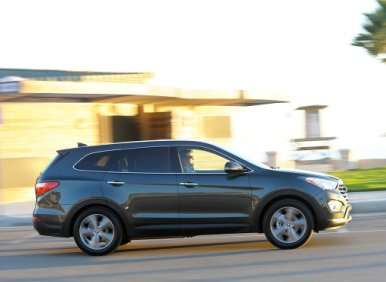
07. The 2013 Hyundai Santa Fe Can Be Loaded With Options
The 2013 Hyundai Santa Fe presents an extensive list of options that can be ordered as either standalone items or grouped in the form of a package. The Santa Fe Sport entry-level model is available with a Popular Equipment Package that provides roof rails, a leather-wrapped steering wheel, seat heaters up front, fog lights, heated mirrors, and power adjustments for the driver’s position. The long-wheelbase edition of the crossover can be had with its own version of the Popular Equipment Package, which includes heated front seats, power adjustment for the driver, fog lights, and heated mirrors, as well as the self-descriptive Leather and Navigation Package (both for the base GLS trim). Leather and Navigation also includes an upgrade sound system, a rearview camera, heated seats for second row riders, and a heated steering wheel. The Technology Package rounds out the Santa Fe Limited’s available options by installing a surround sound system, panoramic sunroof, a heated steering wheel, and a navigation system.
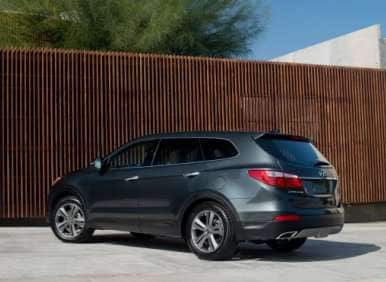
08. The 2013 Hyundai Santa Fe Is A Safe Family Ride
The 2013 Hyundai Santa Fe offers improved safety systems compared to the vehicle it replaces. Specifically, the crossover now comes with a driver’s knee airbag in addition to its dual forward airbags, side impact airbags, and side curtain airbags that are intended to protect passengers in the event of a serious collision or rollover. All versions of the Hyundai Santa Fe come with electronic stability control, traction control, and anti-lock brakes, but only the Santa Fe Limited can be ordered with a blind spot monitoring system. A hill hold feature (to prevent rollback on steep inclines) and a hill descent control system (useful when negotiating serious hills while facing forward) are also standard with every Santa Fe model.
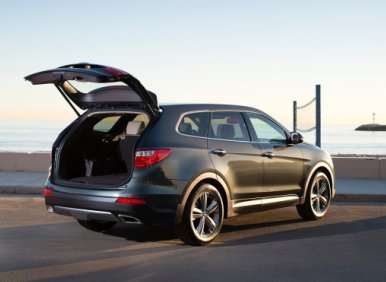
09. The 2013 Hyundai Santa Fe Faces Tough Mid-Size SUV Competitors
The 2013 Hyundai Santa Fe steps into the mid-size SUV segment with swagger, but it’s up against stiff competition when it comes time to do battle with its divisional rivals. The Hyundai Santa Fe Sport is battling against long-time top performers such as the Honda CR-V and the Toyota RAV4, as well as an in-house challenge from the Kia Sorento. The seven-passenger Santa Fe steps into new territory and takes on the likes of the Dodge Journey, the Nissan Pathfinder, and the Chevrolet Traverse – a mix of vehicles that present diverse sizing, creature comforts, and capabilities while still offering comparable seating and pricing.
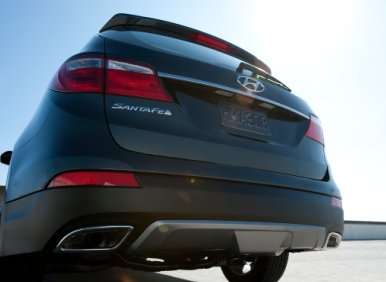
10. The 2013 Hyundai Santa Fe Replaces Two Previous Models
Practiced eyes will notice that there is now a name missing from the Hyundai roster. Scanning the list of available vehicles from the automaker reveals that the Hyundai Veracruz is no longer offered for sale, effectively having been replaced by the long-wheelbase Santa Fe. With the Santa Fe Sport aimed at young families and the Santa Fe seven-passenger picking up the slack for those who need increased hauling capacity, Hyundai has effectively leveraged a single platform to not only update last year’s Santa Fe but also streamline its North American offerings by simplifying its SUV strategy.
